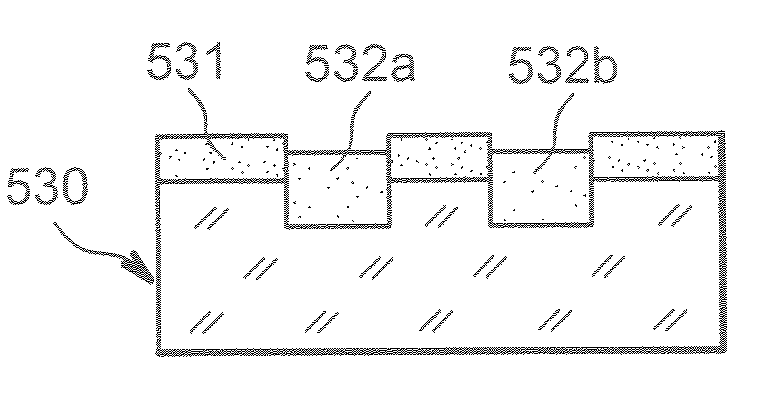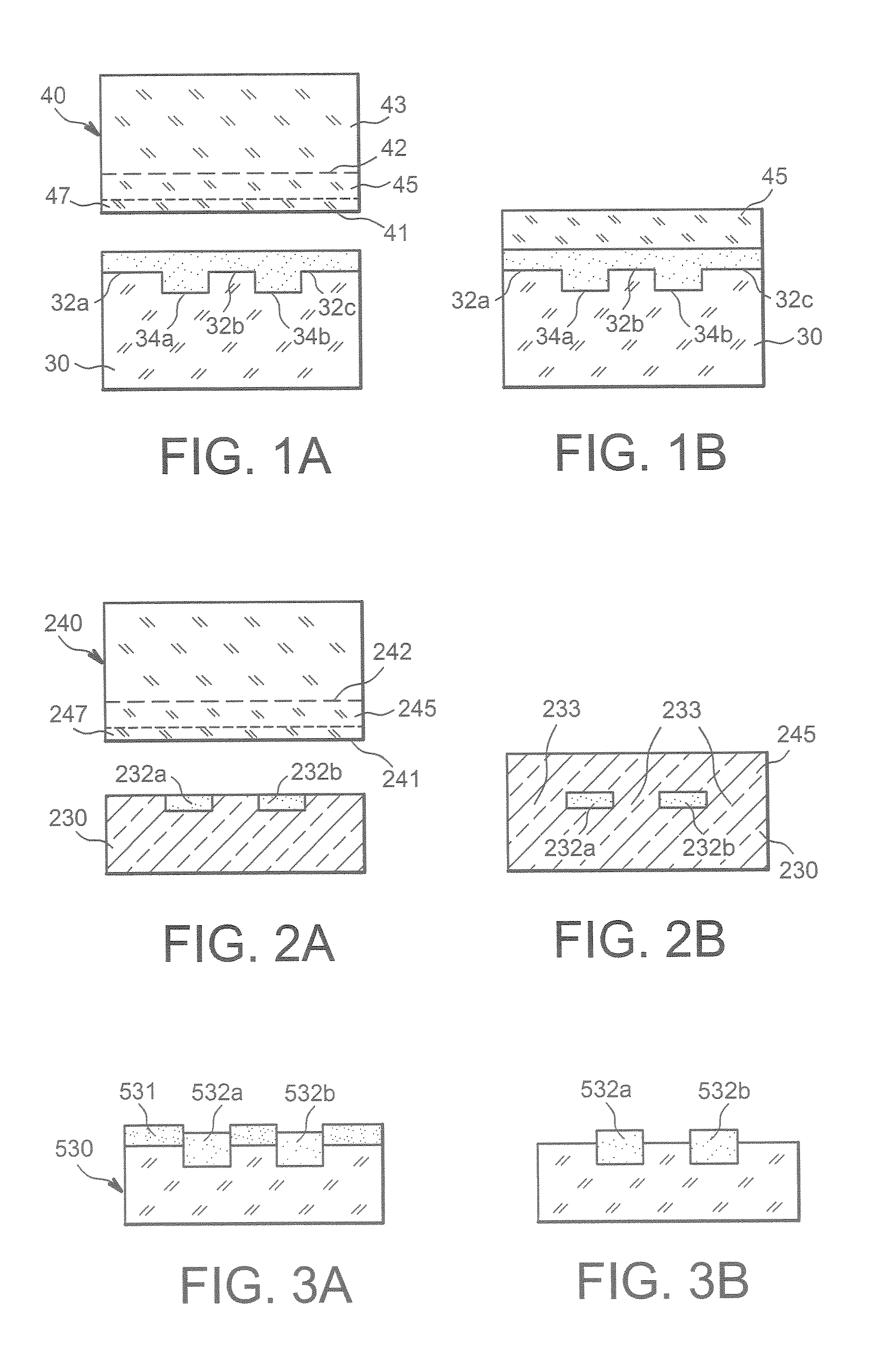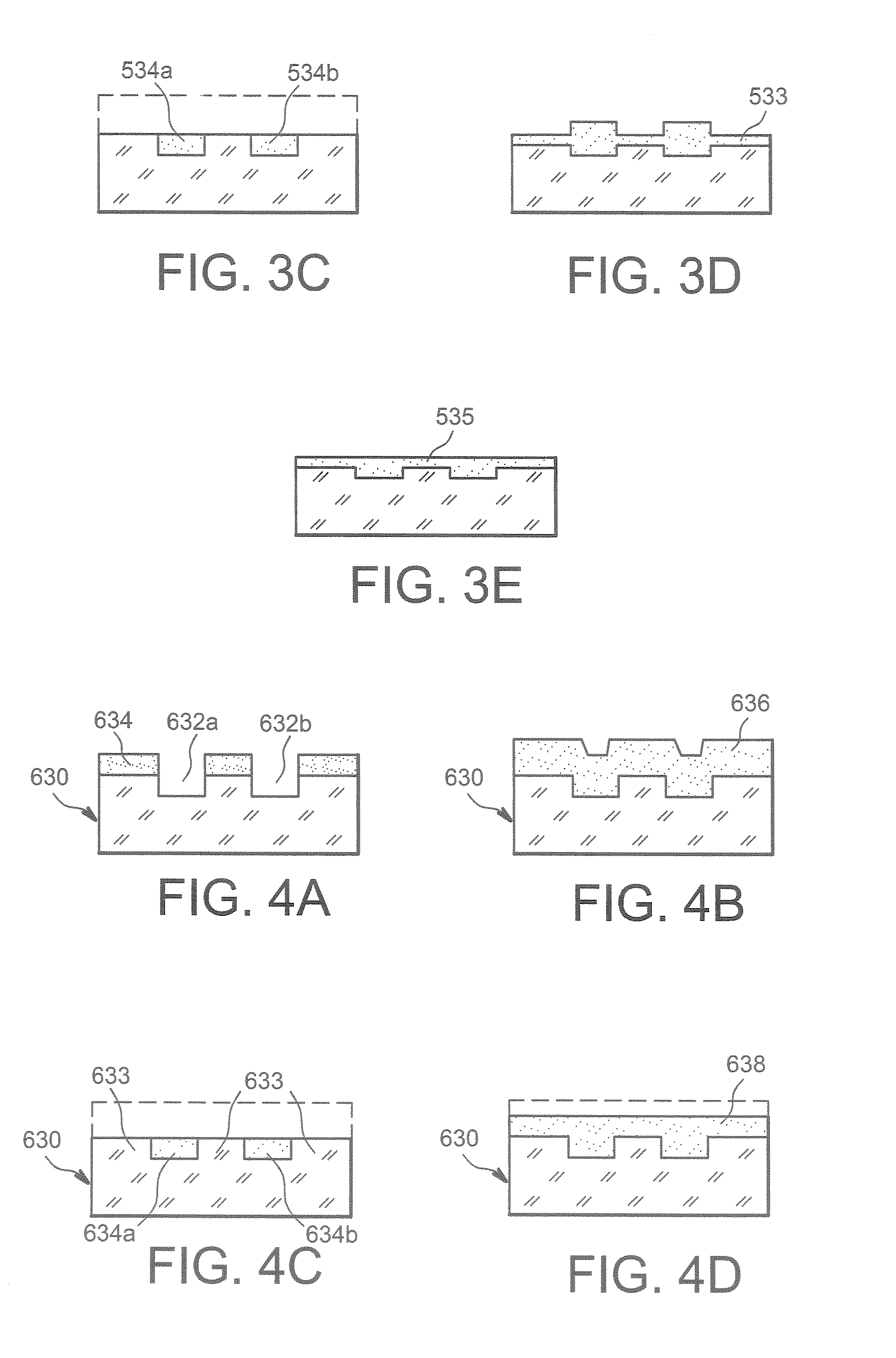Method for providing mixed stacked structures, with various insulating zones and/or electrically conducting zones vertically localized
- Summary
- Abstract
- Description
- Claims
- Application Information
AI Technical Summary
Problems solved by technology
Method used
Image
Examples
first example
[0182]In this first example, the patterns are etched with a reactive ion etching (RIE) type method and have a depth of 50 nanometers in the silicon.
[0183]The SiO2 oxide is generated in these patterns and above the bridges by a heat treatment at 900° C. under a steam atmosphere. Its thickness is 120 nanometers (FIG. 6A).
[0184]A SiO2 film of 150 nm is deposited by PECVD at the surface of the thermal oxide film (FIG. 6B). The topology (surface relief) may be suppressed by CMP polishing. The surface is then smoothed and the deposited oxide film is polished up to the point where the thermal oxide emerges, the beginning of the so-called mixed oxide area (FIG. 6C).
[0185]Densification of the deposited oxide is performed at 900° C. under an oxygen atmosphere for 1 hr.
[0186]Complementary thinning is carried out for example by CMP or by HF etching (HF diluted to 10% or even 1%) or by reactive ionic etching, in a CHF3 plasma for example. The complementary thinning causes no or little > between ...
second example
[0190]In this second example, the patterns are etched with a reactive ion etching (RIE) type method and have a depth of 50 nanometers in the silicon. The oxide is generated in these patterns and above the bridges by heat treatment at 900° C. under a steam atmosphere. Its thickness is 120 nanometers (FIG. 6A).
[0191]A 150 nm SiO2 film is deposited by PECVD at the surface of the thermal oxide film. The topology (surface relief) may be suppressed by CMP polishing. The surface is smoothed and the deposited oxide film is polished up to the point where the thermal oxide emerges, the beginning of the so-called mixed oxide area (FIG. 6C).
[0192]Densification of the deposited oxide is performed at 900° C. under an oxygen atmosphere for 1 hr.
[0193]Complementary thinning is for example carried out by CMP or by HF etching (HF diluted to 10% or even 1%) or by reactive ionic etching, in a CHF3 plasma for example. The complementary thinning causes no or little dishing between the areas of different ...
third example
[0196]In this third example, the patterns are etched with a reactive ion etching (RIE) type method and have a depth of 50 nanometers in the silicon. The oxide is generated in these patterns and above the bridges by a heat treatment at 900° C. under a steam atmosphere. Its thickness is 120 nanometers (FIG. 6A).
[0197]A 150 nm SiO2 film is deposited by PECVD at the surface of the thermal oxide film. The topology (surface relief) may be suppressed by CMP polishing. The surface is smoothed and the deposited oxide film is polished up to the point where the thermal oxide emerges, the beginning of the so-called mixed oxide area (FIG. 6C).
[0198]Densification of the deposited oxide is performed at 900° C. under an oxygen atmosphere for 1 hr.
[0199]Complementary thinning is for example carried out by CMP or by HF etching (HF diluted to 10% or even 1%) or by reactive ionic etching, in a CHF3 plasma for example. The complementary thinning causes no or little dishing between the areas of different...
PUM
| Property | Measurement | Unit |
|---|---|---|
| depth | aaaaa | aaaaa |
| depth | aaaaa | aaaaa |
| width | aaaaa | aaaaa |
Abstract
Description
Claims
Application Information
 Login to View More
Login to View More - R&D
- Intellectual Property
- Life Sciences
- Materials
- Tech Scout
- Unparalleled Data Quality
- Higher Quality Content
- 60% Fewer Hallucinations
Browse by: Latest US Patents, China's latest patents, Technical Efficacy Thesaurus, Application Domain, Technology Topic, Popular Technical Reports.
© 2025 PatSnap. All rights reserved.Legal|Privacy policy|Modern Slavery Act Transparency Statement|Sitemap|About US| Contact US: help@patsnap.com



